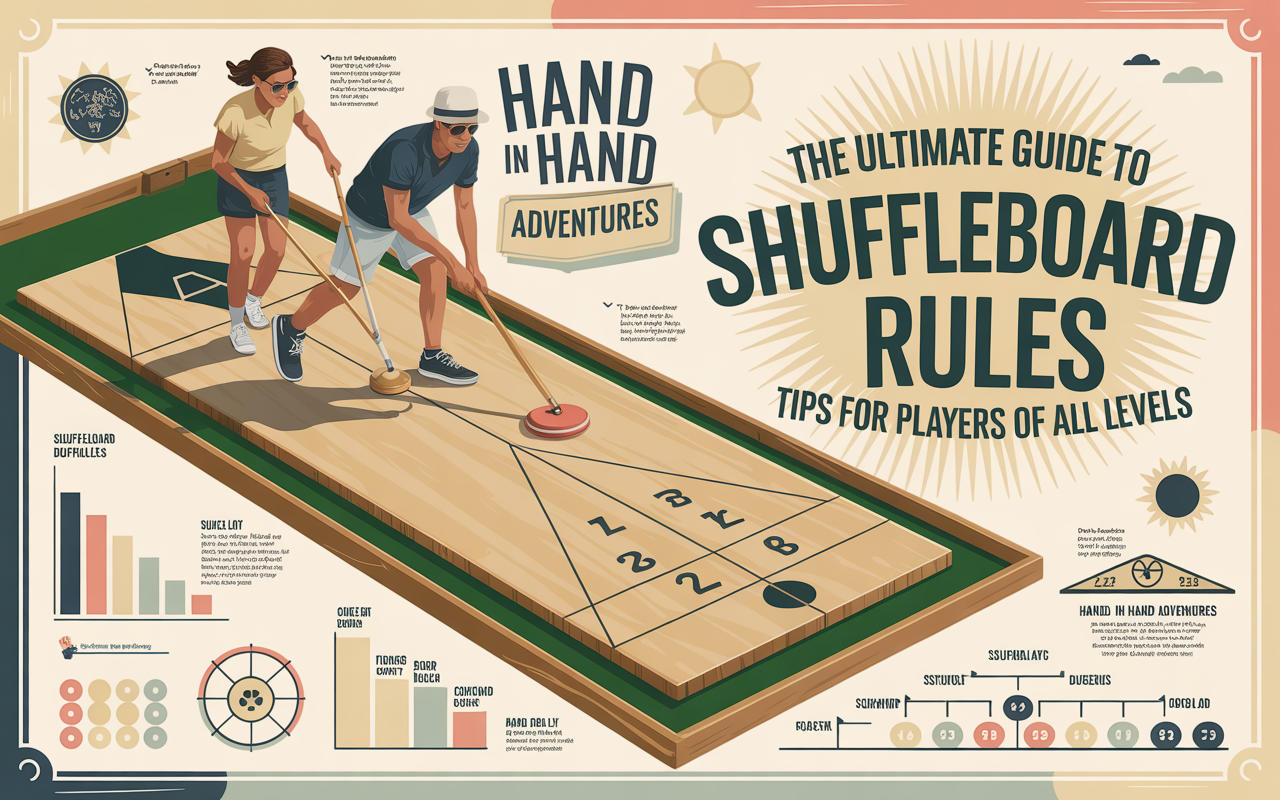Shuffleboard is more than just a game; it’s a blend of strategy, skill, and a dash of friendly competition. Whether you’re enjoying a sunny day at the beach or relaxing in your local bar, shuffleboard provides an entertaining way to pass the time with friends and family. But before you step up to that slick court, it’s crucial to know the ins and outs of shuffleboard rules.
This ultimate guide will unravel everything you need to get started—from basic objectives to advanced techniques that can help elevate your gameplay. So grab your pucks, gather your friends, and let’s dive into the world of shuffleboard!
Basic Rules and Objectives
Shuffleboard is a game of skill and strategy. The primary objective is simple: score points by sliding pucks down the court into designated scoring zones.
Each player takes turns using their cues to push pucks toward the opposite end. Players can aim for higher-scoring areas while also trying to knock opponents’ pucks out of play.
A game typically consists of two players or teams, competing head-to-head. It’s essential to understand that only the nearest puck in a round counts toward scoring.
The first team to reach an agreed-upon point total—often 15, 21, or more—claims victory. Knowing these basics sets you on the right path as you dive deeper into shuffleboard’s exciting nuances!
Equipment and Court Setup
To play shuffleboard, having the right equipment is essential. The most important piece is the shuffleboard table itself. These tables vary in size but typically range from 9 to 22 feet long.
Shuffleboard pucks are another critical component. Made of metal or plastic, they come in various colors and weights. Each player usually has four pucks during a game.
Setting up the court correctly can enhance gameplay. Make sure your table is level; this ensures fair competition and prevents unpredictable puck movements. A smooth surface free of debris allows for optimal sliding.
Don’t forget about scoring zones! Mark these clearly with tape or paint at both ends of the court, establishing clear boundaries for where points are awarded.
Consider adding a scoreboard to track progress easily throughout matches. Keeping everything organized will help maintain focus on strategy rather than logistics.
Scoring System
Understanding the scoring system in shuffleboard is crucial for any player. Points are earned by sliding your pucks into designated scoring areas on the court.
The highest score, 3 points, comes from landing in the farthest zone. This area requires precision and control. A puck resting on the edge can be a game-changer if it doesn’t fall off.
Players must also consider their opponent’s position. If you knock an opponent’s puck out of a scoring zone, you gain strategic advantage while potentially lowering their score.
At the end of each round, only one player scores points based on their pucks that remain within scoring boundaries. It keeps everyone focused and competitive throughout play.
Remember to keep track of your cumulative scores over several rounds as players typically aim for a set target, often 15 or 21 points, to win the match.
Strategies for Beginners
As a beginner, mastering shuffleboard rules can seem daunting. Start by focusing on your stance and grip. Keep your feet shoulder-width apart for balance, and hold the paddle comfortably but firmly.
Aim for consistent strokes. Practice sliding the puck smoothly rather than forcing it. A gentle push often yields better results than a hard shove.
Learn to read the court. Notice how different areas affect puck speed and direction. This awareness will help you strategize effectively during gameplay.
Play defensively when needed. Blocking opponents’ shots is just as crucial as scoring points yourself. Positioning your pucks wisely can disrupt their chances of winning.
Don’t shy away from asking experienced players for tips or advice. They may share valuable insights that enhance your technique and understanding of shuffleboard rules significantly.
Advanced Techniques for Experienced Players
For seasoned shuffleboard players, mastering advanced techniques can set you apart. One effective method is the “weight control” strategy. This involves adjusting the force behind your shots to navigate around blockers or reach difficult scoring zones.
Another technique to explore is angle play. By understanding how your puck interacts with others on the board, you can create advantageous rebounds and place yourself in a more favorable position for future turns.
Additionally, practicing deceptive shots can keep opponents guessing. Use feints or subtle changes in delivery to mislead them about your intended target.
Focus on mental strategies. Visualizing successful plays before executing them helps build confidence and reduces nerves under pressure. Engaging in regular practice sessions reinforces these skills and keeps you sharp against competitors who are also honing their craft.
Common Mistakes and How to Avoid Them
Many players fall into the trap of improper stance. Standing too far back or leaning excessively can throw off balance and precision. Keep your feet shoulder-width apart for a solid foundation.
Another frequent mistake is not aligning the shot properly. Players often aim without considering angles or obstacles on the court. Take a moment to visualize your shot before you push that puck.
Overthinking can also hinder performance. Anxiety about scoring might lead to rushed shots, causing errors. Focus on rhythm and consistency instead; trust your instincts.
Neglecting practice leads to stagnation in skill level. Regularly honing techniques helps maintain sharpness and confidence during games—don’t underestimate warm-up sessions before matches!
Etiquette on the Court
When playing shuffleboard, maintaining good etiquette is as crucial as mastering the rules. Respect for fellow players sets a positive tone for the game.
Always wait your turn patiently. Avoid distractions like chatting or moving around while someone else is shooting. This allows everyone to focus and enjoy their time on the court.
Be mindful of your surroundings. Ensure that you don’t stand in front of other players when they are preparing to take their shots. A simple step back can prevent accidental interruptions.
After each round, congratulate opponents on good plays, regardless of who wins or loses. This sportsmanship enhances camaraderie and makes future games even more enjoyable.
Keep the court clean and orderly by returning all equipment after use. A tidy space reflects respect for both the game and your fellow players’ experience.
Variations of Shuffleboard Games
Shuffleboard offers numerous variations that can spice up gameplay. Each version brings its unique twist, catering to different skill levels and preferences.
One popular variation is “Deck Shuffleboard.” Played on a long court with 4-foot-long pucks, players slide their pucks toward scoring zones at the opposite end. It emphasizes precision and strategy.
Another exciting variant is “Table Shuffleboard,” typically played in bars or game rooms. This form uses a shorter table and smaller pucks, making it fast-paced and perfect for quick games between friends.
For those seeking teamwork, “Doubles” adds an interesting layer of collaboration. Players pair up, strategizing together while aiming for high scores against opposing teams.
Each shuffleboard game brings something new to the table. Whether you prefer casual play or competitive challenges, there’s a variation out there waiting for you to explore!
Resources for Further Learning and Practice
To enhance your shuffleboard skills, exploring various resources is key. Online tutorials on platforms like YouTube provide visual guidance that can be incredibly useful for players at any level. Watching seasoned players in action offers insights into techniques that text alone might not convey.
Books dedicated to shuffleboard strategies also serve as valuable references. They cover everything from basic rules to advanced tactics, giving you a well-rounded understanding of the game.
Joining local clubs or online communities can connect you with fellow enthusiasts who share tips and experiences. Engaging with other players often leads to discovering new strategies and techniques.
Don’t underestimate the power of practice sessions too! Regularly playing against different opponents sharpens your skills and keeps the game fresh. Exploring these resources will undoubtedly elevate your gameplay and deepen your love for shuffleboard.
Conclusion
Understanding shuffleboard rules is essential for players who want to enjoy the game fully. Whether you are a newcomer or an experienced player, mastering the basics can significantly enhance your gameplay experience. The objective remains simple: score points while outmaneuvering your opponent.
With the right equipment and court setup, you’ll be well on your way to enjoying hours of fun. Remember that scoring can vary depending on the specific style you play, so familiarize yourself with those details as well.
As you progress from beginner strategies to advanced techniques, keep practicing. Don’t forget about common mistakes—awareness will elevate your game immensely. Good sportsmanship is crucial too; respecting opponents and maintaining etiquette creates a positive atmosphere for everyone involved.
If you’re eager to dive deeper into different variations of shuffleboard games, many resources are available that cater to all skill levels. Embracing these elements enhances not just individual performance but also enriches group interactions during gameplay.
The world of shuffleboard awaits—all that’s left is for you to step onto the court and start playing!

